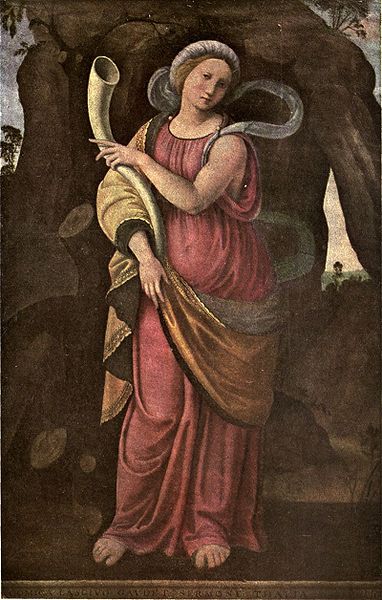Musica a Palazzo Ducale
Sacro & Profano
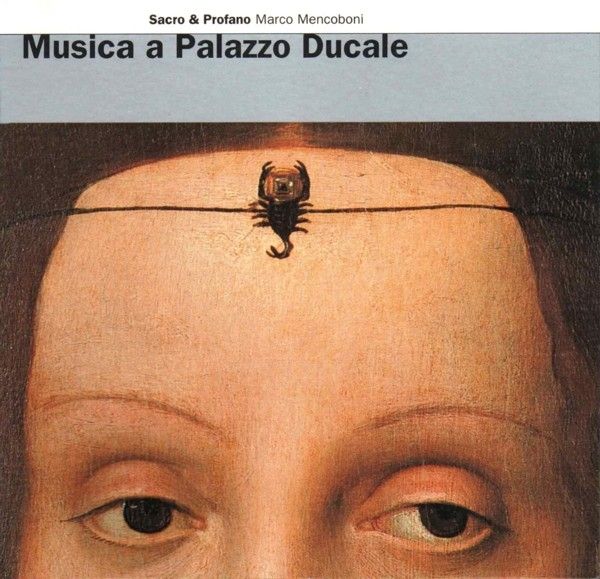
elucevanlestelle.com
E lucevan le stelle CD EL 972307
1997
luoghi di registrazione:
Villa Montani · Ginestreto, Pesaro
Chiesa di S. Agostino · Corinaldo, Ancona
Monastero SS. Salvatore · Fucecchio, Firenze
Guglielmo EBREO da PESARO (ca.1420-ca.1484)
01 - Leoncello [3:10]
02 - Petit Vriens [1:57]
03 - Voltati in ça Rosina [1:27]
Anonimo (XV-XVI sec.)
04 - Japregamore (J'ay pris amour) [2:55]
05 - Bassadanza [4:06]
06 - Tanto me desti [0:57]
Francesco SPINACINO (XV-XVI sec.)
07 - Ave Maria de Josquin [2:48]
Pietro PACE (1559-1622)
08 - Ave Maria [2:28]
09 - Qualis est [2:33]
10 - Cum invocarem [1:43]
11 - Ingredere [2:32]
12 - Ecce domum [2:33]
13 - O quam speciosa [2:35]
Vincenzo PELLEGRINI (XVI sec.-1631)
14 - Canzon la Gentile [1:51]
Bartolomeo BARBARINO 'Il Pesarino' (ca.1565-?)
15 - L'ombre crudeli e sorde (intavolata) [3:05]
16 - M'é piu dolce il penar [2:00]
17 - Son morto hai lasso [3:37]
18 - Ridete pur ridete [2:26]
19 - S'ergano al cielo [2:08]
20 - Serenissima coppia [2:17]
21 - S'avvicina il partire [2:53]
Vincenzo PELLEGRINI
22 - Canzon la Berenice [2:20]
Ignazio DONATI (1575-ca.1638)
23 - Ecce tu pulchra es [3:34]
24 - Benedictus Deus [3:28]
25 - Salve regina [4:44]
26 - Beatus vir [4:24]
Sacro & Profano
Marco Mencoboni
Andrea Damiani, liuto rinascimentale · #1-7
Rosa Dominguez, soprano · #8-13, 16, 17, 21
Roberta Invernizzi, soprano · #9, 10, 12, 13, 23, 25, 26
Nadia Ragni, soprano · #9, 10, 11, 13, 23, 25, 26
Roberto Balconi, controtenore · #11, 12, 26
Gian Paolo Fagotto, tenore · #18, 20
Antonio Abete, basso · #10, 12, 19, 24, 26
Andrea Damiani, chitarrone · #9, 10, 11, 12, 13
Eduardo Egüez, tiorba e tiorbino · #15, 16, 17, 18,
19, 20, 21
Marco Mencoboni, organo e clavicembalo
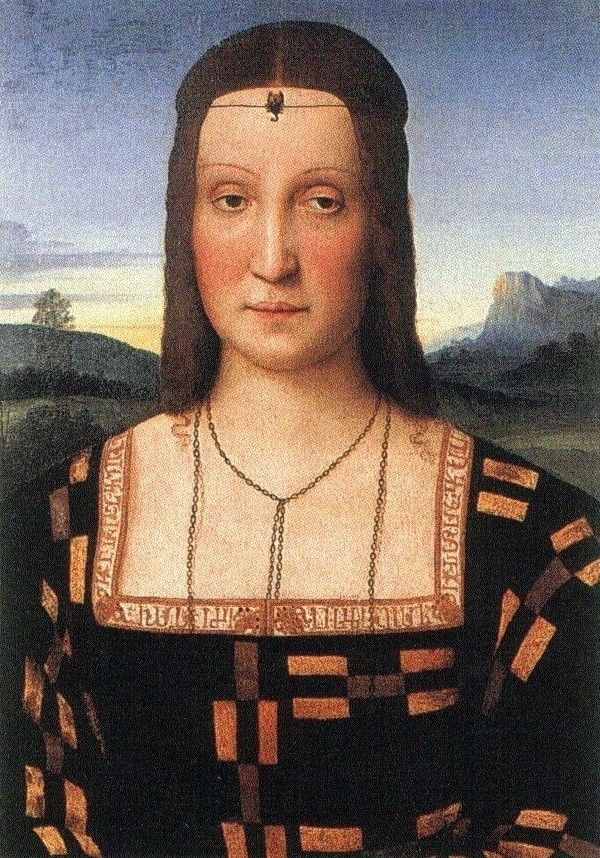
Raffaello Sanzio
Raffaello Sanzio was born in Urbino in 1483. His early years were spent
in the shadow of his father, Giovanni Santi, painter, poet, courtier
and man of culture. From his youth Raffaello was fascinated by the
works of art and beautiful decorations of the palace in which he lived.
Under the tutelage of Perugino, he refined his techique in Perugia and
elsewhere, growing to artistic maturity before the end of the century.
In 1504 he was employed in Florence, his all too brief career being
divided, perhaps too schematically, into two segments: the period until
1508 which he spent in Florence, and the period in Rome, which
culminated with his death in 1520. Above all, during the latter period
when he was employed by the great papal patrons in the Vatican palace,
Raffaello made a dramatic impression on the world of Art. While it is
true that he, together with Michelangelo, created the style we now
identify as Mannerism (which would influence both Italian and European
Art in all its variations for any decades), it is also apparent that
the true gift of Raffaello was his classicism, which derived from a
lively understanding of the style revealed in the ruins of ancient Rome.
The splendid Portrait of Elisabetta Gonzaga is essentially
classical. Although now conserved in the Uffizi gallery in Florence, it
was originally commissioned from the 'divine' painter by the rulers of
Urbino, and for more than a century it hung in the Ducal Palace of
Urbino. The painting portrays the bride of Guidobaldo I of Montefeltro,
who animated festivities and inspired the lively conversations
described by Baldassarre Castiglioni in Il Cortegiano.
Portrayed in a pose of noble melancholy, sweetly idealised and
displaying the jewelled symbol of the scorpion, she is dressed in
bridal raiments which are surprisingly modern to our eyes, dominated by
assymetrical rectangles of silver and gold, while the background is a
moody landscape cloaked in shadow, illuminated by the rays of the
setting sun.
Paolo Dal Poggetto
Superintendent of the Artistic and Historical Patrimony of the Marches,
Urbino
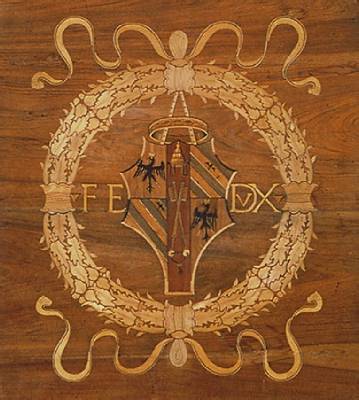
Music at the Ducal
Palace of Urbino
This is the first of what is hoped to be a long series of publications,
studies and performances of music at the court of the Montefeltro and
Della Royere families in Urbino and in other cities in their domains,
examining the relationship between the ruling families and musicians of
the sixteenth and seventeenth centuries, as well as the existence of
various other sources of musical commission in the areas of Urbino and
Pesaro.
The palace of the Montefeltro family in Urbino today houses the offices
of the authorities responsible for safeguarding local art works. One of
the principal objectives of the authorities is to make the stupendous
palace available to the public, and, at the same time, to promote the
National Gallery of the Marches by purchasing works of art by local
artists or by artists who once worked in the area. At the same time, in
the absence of a specific authority dedicated to music, the authorities
take great pride in promoting music which was written for the Marches
and Urbino, by financing (within their limited means) musicological
research and the performance of rare and often unpublished music. And
so it gives us great pleasure to have supported the research of Marco
Mencoboni, who has focused his attention for many years on music of the
seventeenth century and earlier which was commissioned by the courts or
churches of the Marches.
The active exchange between the authorities and maestro Mencoboni began
some time ago, as a result of the concerts which he performed in the
Palace during the last two editions of the Fine Arts Week. It is worth
remembering that for more than a year now Baroque music has been
broadcast for an hour every day in the Ducal Palace, an event which
stands alone in the chronicles of Italian museums.
To help defray the not indifferent costs of producing a compact disc of
such quality in a musical sector which is still little known, Poltrona
Frau of Tolentino came forward, and I would like to thank the
company personally for its great generosity. The music has been
exquisitely performed on this recording by Sacro Profano, directed by
Marco Mencoboni, while the introductory essay is fruit f the research
of Prof. Franco Piperno of the University of Florence, to whom we are
also extremely grateful.
This recording is intended as a foretaste of the delights in store of
the Della Rovere musical world, which will be completed - and this
dream is not mine alone - by bringing to light that fascinating opera
by Pietro Pace, the Ilarocosmo, which is full of symbols and
Baroque effects, and is noteworthy in the first instance for its
scenography, which included personification of the Rivers and he Trees
(clear references to the members of the Della Royere family).
The opera was composed in 1621 on the occasion of the marriage of
Federico Ubaldo, the last of the family line, to Claudia de' Medici, a
union intended to join the two great families. Unfortunately, the opera
was never performed, as a consequence of the State mourning imposed by
the sudden death of the bride's brother. At the same time, the
religious music of Pietro Pace is well-represented on this cd. Pace was
the maestro di cappella in Loreto, and was often present at the
court of Pesaro and, we can only suppose, at the court of Urbino too.
This recording also provides a rare example of music from the fifteenth
century, the chanson 'J'ay pris amour', which was also represented in
the wooden inlay carvings of Duke Federico's small private study in
Urbino, and which seems to suggest that it was one of his favourite
pieces. Music was an integral part of courtly life throughout the
sixteenth century, and even earlier, and it was of particular
importance in the courts of the Montefeltro and Della Rovere families,
and this fact is clearly evident in the numerous paintings which adorn
the palace, as well as in the decorations of the building itself.
Alongside the inlay carvings already mentioned, we need only think of
the splendid 'Apollo' which animates the great door leading from the Sala
degli Angeli (Angel Room) to the so-called Sala del Trono
(Throne Room), the room where banquets and balls were held. Of equal
importance, the representation of 'The Muses', which were painted by
Giovanni Santi and Timoteo Viti for the decoration of the Tempietto of
the same name in the public area on the ground floor of the Ducal
Palace. These are conserved today (though only in part, unfortunately)
in the Corsini Gallery in Florence. Each figure was distinguished by a
musical instrument - the lute, the organ, and the trumpet, for example.
And even while the sound of music diminished in the palace, as the
morbid and gloomy 'Spaniard', Francesco Maria II, meditated painfully
on the impending extinction of his house, the prince's favourite
artist, Barocci, painted a 'Saint Cecilia' for the cathedral of Urbino
which includes a moving evocation of musical instruments, a portable
organ negligently held upside down being one of the delightful features
of the work.
While all, or almost all, the pieces of music performed on this
recording were once heard in the Ducal Palace of Urbino (many, indeed,
were expressedly commissioned by the Della Rovere family), it is more
problematical to hypothesise with certainty the rooms of the palace
which were set aside for musical entertainment. It is very probable,
though not absolutely certain, that music was played in various parts
of the palace: apart from the Throne Room - a space which was used for
receptions and concerts - the Audience Room on the first floor, and the
Banquet Room on the ground floor were used for performances by visiting
musicians, or by artists invited to play in Urbino by Federico, or in
Pesaro and other ducal residences throughout the sixteenth century by
his successors. Federico counted many musicians among the paid members
of his court, and I hope that we will soon have more precise details of
their names, the instruments on which they excelled and the music which
the Duke requested them to play, apart from the famous O rosa bella
or his beloved J'ay pris amour.
Paolo Dal Poggetto
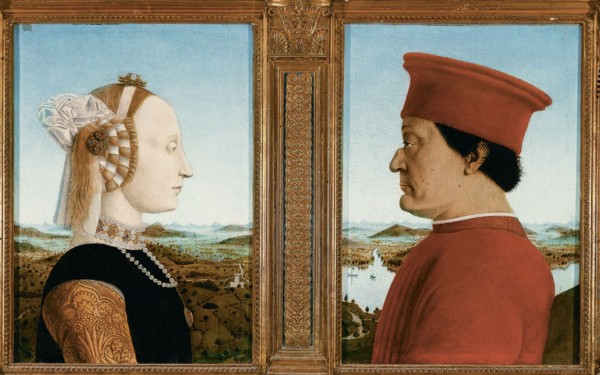
Music at court from
Montefeltro to Della Rovere
The court: a place to live, a place of power, of pageantry, centre of
entertainment, a place of private plotting and public ceremony. And in
the background, an underlying tapestry, music: sometimes ornamental,
often a symbol of aristocratic splendour, accompanying the various
activities of the prince and his courtiers, a muted but incisive
element in the halls of the palace, a seductive and emblematic
presence, representing the extemporary character of the place itself
and its rituals, reflecting also an instinctive reluctance to commit
anything to paper.
The Italian Renaissance rediscovered and reassessed the Platonic notion
of the regenerative power of music, an integral feature of the
representation of perfect government and the prosperity of the state:
the humanist prince is, therefore, by definition interested in music,
surrounding his person with its symbols and taking every opportunity to
associate music with the occasions in which he exercises power, whether
in public celebration or for his private delight. In the latter part of
the fifteenth century, Urbino came to exemplify this philosophy.
Marsilio Ficino considered Federico of Montefeltro to be an ideal
prince governing an ideal city, while Vespasiano of Bisticci,
Federico's biographer, insists on the culture and the musical
refinement of the Duke of Urbino, a fact which he omits to mention with
regard to other protagonists of his Lives: "the Duke was
greatly pleased by music and knowledgeable both of singing and of
playing, and had a cappella di musica containing the most
excellent musicians [...] there was hardly an instrument which he did
not have in his court, nor one in which he did not delight, and he
employed the most expert players of many instruments [...]". The palace
of Urbino was enriched in Federico's time with decorations (frescoes,
bas reliefs, sculptures, wooden inlay work) which remind the visitor
continually of the Perfect alliance of music, culture and politics
which reigned there.
As recent studies have demonstrated (N. Guidobaldi), the role of music
as a symbol of enlightened government reached extraordinary heights in
Urbino with regard to the decoration of various parts of the palace,
particularly the private study of the prince, and in the room which
once contained the Allegory of Music by Giusto of Gand,
together with three other allegorical subjects (representing Argument,
Astronomy and Rhetoric). In the private study, the iconography refers
to the daily importance of music in the court, representing objects
belonging to the Duke and used by his musicians, as well as indicating
their repertoire: the music of J'ay pris amour, a popular
chanson which is inlaid in one wall of the study, and which was used
during the feast celebrating the arrival in Urbino of Federico of
Aragon, a powerful ally of Montefeltro, undeniable testimony of a
significant political occasion in which music played its part.
Concerning the Allegory painted by Giusto of Gand, a figure kneeling
before the Muse, traditionally held to be Costanzo Sforza, Lord of
Pesaro, has been recently identified as the dancing-master, Guglielmo
Ebreo of Pesaro, the most representative musician of the court and most
important choreographer of the Italian Renaissance, whose De
pratica seu arte tripudii vulgare opusculum was dedicated to
Federico, testifying to the importance of dancing at the Court of
Urbino.
Music was used inevitably in the context of feasts, whether of dynastic
or diplomatic importance, and carnival entertainments, as well as for
private enjoyment by the Prince. The names of some of the performers
have survived in contemporary documents: Pietrobono dal Chitarrino, for
example, a lutenist from Ferrara, who was one of the most renowned
performers of the day. Many other names have been lost, their role
remembered, however, in the iconography mentioned previously. The
musical repertoire was in the most elaborate French style (Binchois,
Dufay, Okeghem, Dunstable, Ciconia), although it also included Italian
pieces of note, such as the well-known, O rosa bella, of which
two arrangements exist, one in Vatican Codex Urbinate 1411, which once
formed part of Federico's library, the other in an inlay panel from
another (dismantled) study of the Duke in the palace of Gubbio, which
is now conserved in the Metropolitan Museum, New York. Gubbio was
greatly loved by Federico and he built a palace here, a sort of minor
branch of the palace in Urbino, both in its use and for the presence
there of music: the employment and the meaning of the musical arts
within a princely court stretched out from the capital city and
extended to every place in which the prince chose to reside, even on a
temporary basis. This was the singular prerogative of the dukes of
Urbino (the Montefeltro family in the first instance, the Della Rovere
dynasty afterwards), and it is unequalled in other courts, where
musical patronage rarely went beyond commissioning music for civic
occasions, or, more rarely, for entertainment and pleasure. By
contrast, in the Dukedom of Urbino courtly music was heard by the
Duke's expressed wish in all of the smaller centres too: first in
Gubbio and Casteldurante, then in Pesaro which would later become the
capital city), in Fossombrone, Senigallia and Cagli, to the extent that
the term 'court music' should not be restricted simply to the capital
city.
The tradition is even more strongly represented in the Della Royere
dynasty which succeeded the extinct Montefeltro line in 1508, when the
adopted son of Guidobaldo of Montefeltro, Francesco Maria I, came to
power. He added the city of Pesaro, of which he was the ruler, to the
Dukedom of Urbino, and thus Urbino gained its first sea-port.
Senigallia soon came under the sway of the Della Rovere family, and it
was to become the most important commercial centre of the Dukedom. In
the 1520s Pesaro was chosen as the new capital of the Dukedom, Urbino
being used as a summer residence for the court, though occasional
visits were made to Casteldurante and Mondavio for the purpose of
hunting, while musical and literary occasions were celebrated at the
Imperial palace. Eleonora Gonzaga, Francesco Maria's wife, chose
Fossombrone as her favourite residence after the death of her husband
in 1538, while their son, Guidobaldo II, began to enlarge and decorate
the palace of Pesaro, extensively rebuilding the city, as well as
ordering the construction of the fortifications in Senigallia.
Guidobaldo's brother, Giulio Della Rovere, Cardinal of Urbino, selected
the Red Court of Fossombrone as his favourite residence. This is the
reason why there are so many Urbinate palaces in the sixteenth century,
all of which enjoyed the artistic patronage of the family, a distinct
preference being shown for musical entertainments.
The renowned lutenist, Joannangelo Testagrossa, came from Mantova to
serve Duke Francesco Maria in the palaces of Pesaro and Urbino; Antonio
Cavazzoni came to entertain the sick Duchess Eleonora in 1525 and he
returned in 1533 to supervise the carnival celebrations; the organist,
Giaches Brumel, won widespread admiration for his virtuosity in the
summer of 1534, returning to Pesaro once again in the Spring of 1562;
the carnival of 1544 was marked by the presence of Antonio dal
Cornetto, who was loaned to Guidobaldo by the Duke of Ferrara, while in
the same year the most important of contemporary Flemish musicians,
Domenique Phinot, was 'recommended' to the town council of Pesaro, and
employed by the Duke himself directly afterwards; another Fleming,
Olivier Brassart, was in the service of Cardinal Giulio, while Monaldi
Atanagi, singer, dancer, 'cembalist' and clown, made his appearance in
Fossombrone, Casteldurante, Urbino and Pesaro; the Imperial theatre and
the private quarters of the Palace of Pesaro heard the enchanting voice
of the 'mermaid', Virginia Vagnoli, accompanied by court musicians such
as Paolo Animucci, the organist Giachet Bontemps, the lutenist Stefano
de' Ferrara, and the bass Paolo Pighini, as a letter by Ludovico
Agostini of Pesaro, one-time fiancé of Vagnoli, recounts in his
unpublished manuscript, Giornate soriane (ms. 191, Biblioteca
Oliveriana, Pesaro). Music was heard throughout the territories of the
Dukes of Urbino, not merely in the palace of Urbino itself, which
tended to be ignored by the Della Rovere family as a residence, but in
all of the palaces which came under their patronage; music in the form
of private or public entertainment.
This golden age came to an end in the latter sixteenth century in the
reign of Francesco Maria II who ruled as Duke from 1574 until his death
in 1631, the line dying out with him. Music played a less important
role in his reign and fell silent in the end, its place taken by study,
literature, the collection of books, and philosophical and religious
meditation. One of the final acts in this decline was the performance
of Torquato Tasso's L'aminta in Pesaro during the carnival of
1574, soon after its first performance in Ferrara.
The impulse was provided by Lucrezia d'Este, the refined and,
unfortunately, neglected first wife of Francesco Maria. The performance
was directly personally by the author himself, who may, perhaps, have
heard some of the musical works which were published in 1598 by Simone
Balsamino of Urbino under the title Novellette a sei voci, with
a dedication to the Duke and the citizens of the city. A musical
entertainment by Ignazio Brace and Pietro Pace, L'Ilarocosmo, o sia
il mondo lieto, was planned to celebrate the marriage in 1621 of
Federico's heir (by Livia Della Rovere, his second wife) to Claudia de'
Medici, though it was never performed, and Federico Ubaldo died
tragically in 1623, eight years before his father. This missed musical
opportunity would have been the first instance in the Marches of a new
type of theatre, accompanied melody (i.e., operatic melodrama), which
had been perfomed for the first time and with success in Florence and
Mantova only a few years previously.
If music was muted at the court, it continued to be heard in the
private residences of the nobles, who began to take the place of the
Duke as patrons. Ippolito and Giuliano Della Royere, natural sons of
the Cardinal of Urbino, the Bartoli, Gallo, Albani, Bonamini,
Barignani, Almerici, Mario and Accorimboni families became the new
patrons at the end of the sixteenth century, and in the early years of
the seventeenth century their palaces resounded to the notes of the
most important musicians of the time, Pietro Pace of Loreto, Bartolomeo
Barbarino of Fabriano and Galeazzo Sabbatini of Pesaro, while the halls
of the Dukes fell silent forever.
Franco Piperno
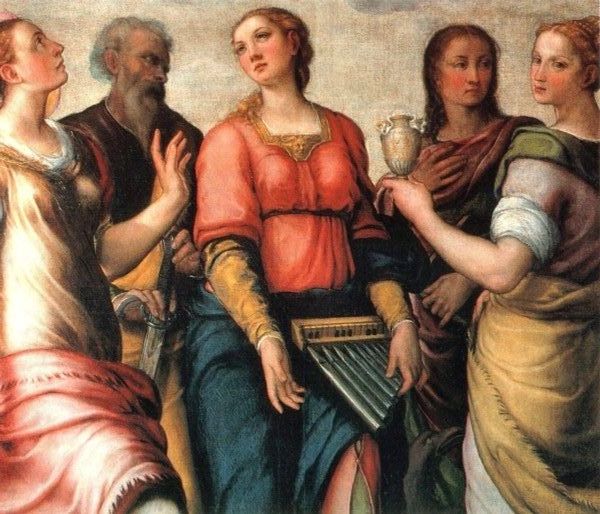
The Composers
Guglielmo Ebreo da Pesaro, dancer and musician, was born around
the year 1420 in Pesaro. His father, Mosè di Sicilia, was
dancing-master at the court. Guglielmo entered the service of
Alessandro Sforza, the ruler of Pesaro, and he was present in Urbino at
the wedding of Federico da Montefeltro, whose service he entered after
Alessandro's death. He wrote an important treatise, De pratica seu
arte tripudii (1463), which has survived in numerous editions and
describes the choreography of contemporary dancing and the recommended
method of playing the accompanying instruments.
The pieces by an unknown composer presented here are all taken
from the chord-form manuscript which is conserved at the Biblioteca
Oliveriana in Pesaro. The volume is quite exceptional, not only on
account of its musical contents, but also for the information of
historical and cultural value which it contains. The volume was
compiled over a period of almost two hundred years and is a compendium
of the music played in this geographical area. The collection of pieces
for lute includes Japregamore (J'ay pris Amour) which is the
instrumental version of a well-known song which was popular throughout
Europe, and which Duke Federico da Montefeltro chose as a wooden inlay
motif for his private study in the palace of Urbino.
Two books of lute entablature by Francesco Spinacino (XV-XVI
century) were published in Venice in 1507 by Ottaviano Petrucci of
Fossombrone, the first ever to have been published. The printing was a
refined technical procedure which began with the musical stave, adding
the note numbers and elaborate headings in successive phases. As such,
the publications are among the most precious examples of the printer's
art. Information about the composer's life is restricted to what can be
gleaned from these editions. The composer was probably a fellow-citizen
of Petrucci, perhaps of noble birth, certainly a lute virtuoso. Verses
written in praise of his playing suggest that his name was derived from
the word 'spina' or 'thorn' (which was used as a plectrum), exciting
the ear without injuring the hand. Spinacino's art is closely tied to
the lute tradition of the latter part of the fifteenth century.
Pietro Pace was born in Loreto in 1559, and performed as
organist at the Santa Casa of Loreto from 1591 to 1593. He was employed
at Pesaro in 1597, and returned to Loreto in the period from 1611 to
1622. He also served the della Rovere family. His Quinto libro de
motetti, op. 10 which was published in 1615, was written as the
frontispiece suggests, "in praise of the Most Glorious Virgin Mary"
while he was employed at the Santa Casa of Loreto. It was dedicated to
Sister Maria (Eleonora) della Rovere, to whom he had given musical
instruction when she was a child, and included compositions for one to
six voices.
Born in Pesaro, canon of the Cathedral and probably an organist, Vincenzo
Pellegrini (second half of the sixteenth century-1632) was
appointed Maestro di Cappella to the Cathedral of Milan, where
he remained until his death. His collection of Canzoni di
intavolatura d'organo fatte alla francese (Venice 1599) was
dedicated to Livia della Rovere, the bride of Francesco Maria II, Duke
of Urbino. The works employ counterpoint and anticipate a style which
was increasingly popular in that period. The compositions are
constructed in various sections which use contrasting types of musical
writing (chordale or imitative), as well as different tempos and rhythm.
Bartolomeo Barbarino, who was known as il pesarino, was
born in the town of Fabriano in the Marches. He first came to public
attention in 1593 or 1594 as a counter-tenor singing in the choir of
the Santa Casa of Loreto. By 1602 he had been called to the service of
Monsignor Giuliano della Royere in Urbino, and he also appears to have
been employed in the same period by the Duke of Urbino, as the composer
mentions in the dedication of his published collection of madrigals in
1604. He was one of the first to write songs for a single voice and was
one of the most enthusiastic proponents of this particular musical
form. Indeed, almost all of his compositions, whether written for
performance in the church or in the court, belong to this genre.
Ignazio Donati was born in Casalmaggiore around 1575. He was
active in the Marches in the cities of Urbino, Pesaro and Fano, before
moving to the north, where he ended his career as Maestro di
Cappella at the Milan Cathedral from 1631 to 1638. He was the
inventor of a praxis known as Cantar lontano, which consisted
of polyphonic vocal effects produced by the positioning of various
groups of singers at a distance from one another.
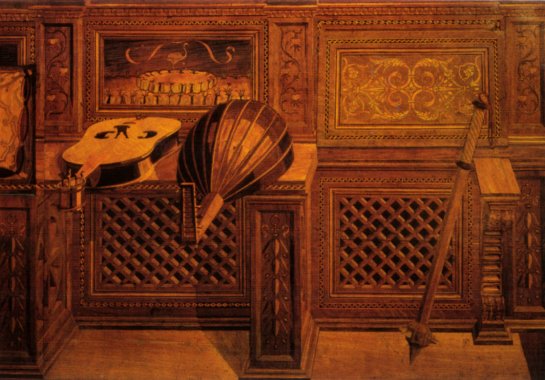
Sources
Anonimo
Biblioteca Oliveriana, Pesaro, MS 1144
Francesco Spinacino
Intabolatura de lauto Libro I, Venezia, Ottaviano Petrucci, 1507.
Guglielmo Ebreo da Pesaro (Giovanni Ambrosio)
De pratica seu arte tripudii, Paris, Bibliothèque
Nationale, fonds ital. 476.
Domenico da Piacenza, De arte saltandi et choreas ducendi,
Paris, Bibliothèque Nationale, fonds ital. 972.
Vincenzo Pellegrini
Canzoni de intavolatura d'Organo fatte alla francese, di Vincenzo
Pellegrini canonico di Pesaro, libro primo, Venezia, Giacomo
Vincenti, 1599.
Pietro Pace
Il Quinto libro de Motetti a Una, Due, Tre, Quattro, & Cinque
voci in lode della gloriosissima Vergine Maria con il suo basso per
sonar nell'organo. Di Pietro Pace organista di Santa Casa di Loreto.
Opera Decima, In Venezia, appresso Giacomo Vincenti, 1615.
Bartolomeo Barbarino
Madrigali di diversi autori posti in musica da Bartolomeo Barbarino
da Fabriano per cantare sopra il chitarrone, clavicembalo o altri
instrumenti da una voce sola, libri primo e secondo, In Venetia
appresso Ricciardo Amadino, 1606.
Ignazio Donati
Ignatii Donati Ecclesiae Metropolitanae Urbini Musicae Praefecti.
Sacri Concentus unis, binis, ternis, quaternis, & quinis vocibus,
una cum parte organica, Venezia, Giacomo Vincenti, 1612.
